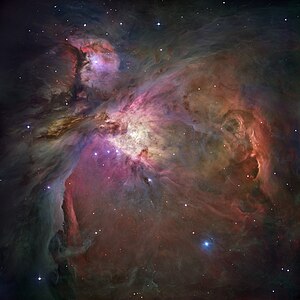| Diffuse nebula | |
|---|---|
 The entire Orion Nebula in a composite image of visible light and infrared; taken by Hubble Space Telescope in 2006 | |
| Observation data: J2000 epoch | |
| Subtype | Reflection/Emission[2] |
| Right ascension | 05h 35m 17.3s[1] |
| Declination | −05° 23′ 28″[1] |
| Distance | 1,344±20 ly (412[3] pc) |
| Apparent magnitude (V) | 4.0[4] |
| Apparent dimensions (V) | 65×60 arcmins[5] |
| Constellation | Orion |
| Physical characteristics | |
| Radius | 12[a] ly |
| Absolute magnitude (V) | -4.1 |
| Notable features | Trapezium cluster |
| Designations | NGC 1976, M42, LBN 974, Sharpless 281 |
The Orion Nebula (also known as Messier 42, M42, or NGC 1976) is a diffuse nebula situated in the Milky Way, being south of Orion's Belt in the constellation of Orion,[b] and is known as the middle "star" in the "sword" of Orion. It is one of the brightest nebulae and is visible to the naked eye in the night sky with an apparent magnitude of 4.0. It is 1,344 ± 20 light-years (412.1 ± 6.1 pc) away[3][6] and is the closest region of massive star formation to Earth. The M42 nebula is estimated to be 24 light-years across (so its apparent size from Earth is approximately 1 degree). It has a mass of about 2,000 times that of the Sun. Older texts frequently refer to the Orion Nebula as the Great Nebula in Orion or the Great Orion Nebula.[7]
The Orion Nebula is one of the most scrutinized and photographed objects in the night sky and is among the most intensely studied celestial features.[8] The nebula has revealed much about the process of how stars and planetary systems are formed from collapsing clouds of gas and dust. Astronomers have directly observed protoplanetary disks and brown dwarfs within the nebula, intense and turbulent motions of the gas, and the photo-ionizing effects of massive nearby stars in the nebula.
- ^ a b "NGC 7538". SIMBAD. Centre de données astronomiques de Strasbourg. Retrieved October 20, 2006.
- ^ Gater, Will; Vamplew, Anton (2010). The Practical Astronomer (1st American ed.). London: DK Pub. p. 242. ISBN 978-0-7566-7324-6.
- ^ a b Reid, M. J.; et al. (2009). "Trigonometric Parallaxes of Massive Star Forming Regions: VI. Galactic Structure, Fundamental Parameters and Non-Circular Motions". Astrophysical Journal. 700 (1): 137–148. arXiv:0902.3913. Bibcode:2009ApJ...700..137R. doi:10.1088/0004-637X/700/1/137. S2CID 11347166.
- ^ "NGC 1976 = M42". SEDS.org. Retrieved December 13, 2009.
- ^ Revised NGC Data for NGC 1976 per Wolfgang Steinicke's Revised New General Catalogue and Index Catalogue.
- ^ Hirota, Tomoya; et al. (2007). "Distance to Orion KL Measured with VERA". Publications of the Astronomical Society of Japan. 59 (5): 897–903. arXiv:0705.3792. Bibcode:2007PASJ...59..897H. doi:10.1093/pasj/59.5.897.
- ^ Ripley, George; Dana, Charles A., eds. (1879). . The American Cyclopædia.
- ^ Press release, "Astronomers Spot The Great Orion Nebula's Successor Archived 2006-02-18 at the Wayback Machine", Harvard-Smithsonian Center for Astrophysics, 2006.